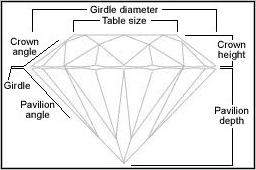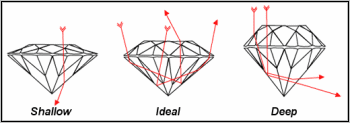The cut of a diamond determines its brilliance. There is no single measurement of a diamond that defines its cut, but rather a collection of measurements and observations that determine the relationship between a diamond’s light performance, dimensions and finish. Most gemologists consider cut the most important diamond characteristic because even if a diamond has perfect color and clarity, a diamond with a poor cut will have dulled brilliance.
 How a Diamond is Cut
How a Diamond is Cut
Determining a diamond’s cut grade, however, goes beyond simple measurements of width and depth. Using an optical measuring device, a three-dimensional model is created to determine the diamond’s proportions and angles. The interrelations between these various dimensions will greatly affect how light reacts once it enters and how it behaves once it exits; by using sophisticated computer modeling, it is possible to trace light behavior and measure its levels of brightness, fire and scintillation – the face-up appearance.
Diameter : The width of the diamond as measured through the girdle.
Table : The largest facet of a gemstone.
Crown : The top portion of a diamond extending from the girdle to the table.
Pavilion : The bottom portion of a diamond, extending from the girdle to the culet.
Culet : The facet at the tip of a gemstone. The preferred culet is not visible with the unaided eye (graded “none” or “small”).
Girdle : The intersection of the crown and pavilion which defines the perimeter of the diamond.
Depth : The height of a gemstone measured from the culet to the table.

The width and depth can have an effect on how light travels within the diamond, and how it exits in the form of brilliance.
Too Shallow: Light is lost out the bottom causing the diamond to lose brilliance.
Too Deep: Light escapes out the sides causing the diamond to appear dark and dull.
Polish and Symmetry
Polish and symmetry are two important aspects of the cutting process. The polish grade describes the smoothness of the diamond’s facets, and the symmetry grade refers to alignment of the facets. With poor polish, the surface of a facet can be dulled, and may create blurred or dulled sparkle. With poor symmetry, light can be misdirected as it enters and exits the diamond. The polish and symmetry grades are clearly listed in each diamond detail page and within the GIA or AGSL diamond grading report. For the most beautiful diamond, look for a symmetry grade of excellent (EX), very good (VG), or good (G) for a GIA graded diamond, and ideal (ID), excellent (EX), very good (VG), or good (G) for an AGSL graded diamond. Avoid diamonds with symmetry grades of fair (F) or poor (P), as the alignment of their facets may misdirect light so severely that it affects the brilliance of the diamond.
Diamond Cut Grading
Diamond measurements are calculated and applied to a cut grading scale that makes it easy to understand how well each reflect light:
- Ideal cut: Represents roughly the top 3% of diamond quality based on cut. Reflects nearly all light that enters the diamond. An exquisite and rare cut.
- Very good cut: Represents roughly the top 15% of diamond quality based on cut. Reflects nearly as much light as the ideal cut, but for a lower price.
- Good cut: Represents roughly the top 25% of diamond quality based on cut. Reflects most light that enters. Much less expensive than a very good cut.
- Fair cut: Represents roughly the top 35% of diamond quality based on cut. Still a quality diamond, but a fair cut will not be as brilliant as a good cut.
- Poor cut: This includes all diamonds that do not meet the performance standards of a fair cut. These diamonds are generally deep and narrow or shallow and wide and tend to lose most of the light out the sides and bottom.
